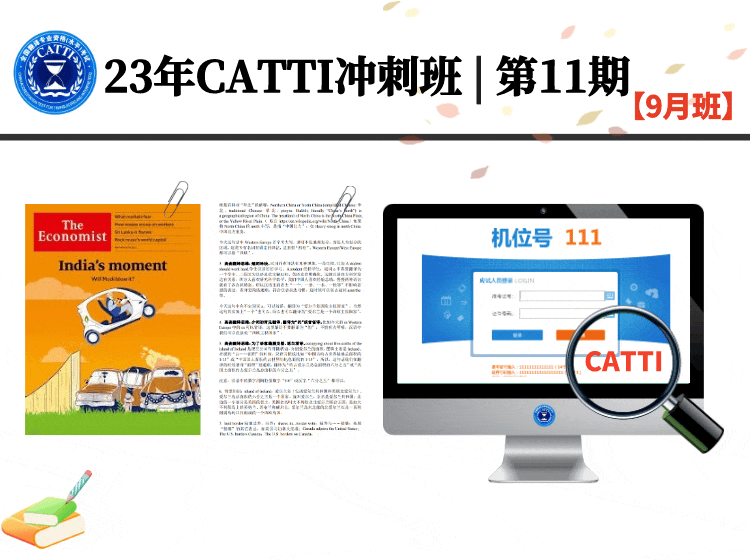第二十五届韩素音青年翻译奖竞赛英译汉一等奖获奖译文
原文Globalization
A fundamental shift is occurring in the world economy. We are moving rapidly away from a world in which national economies were relatively self-contained entities, isolated from each other by barriers to cross-border trade and investment; by distance, time zones, and language; and by national differences in government regulation, culture, and business systems. And we are moving toward a world in which barriers to cross-border trade and investment are tumbling; perceived distance is shrinking due to advances in transportation and telecommunications technology; material culture is starting to look similar the world over; and national economies are merging into an interdependent global economic system. The process by which this is occurring is commonly referred to as globalization.
Correspondent: Globalization has been one of the most important factors to affect business over the last twenty years. How is it different from what existed before? Companies used to export to other parts of the world from a base in their home country. Many of the connections between exporting and importing countries had a historical basis. Today, to be competitive, companies are looking for bigger markets and want to export to every country. They want to move into the global market. To do this many companies have set up local bases in different countries. Two chief executives will talk about how their companies dealt with going global. Percy Barnevik, one of the world’s most admired business leaders when he was Chairman of the international engineering group ABB and Dick Brown of telecommunications provider Cable & Wireless.
Cable & Wireless already operates in many countries and is well-placed to take advantage of the increasingly global market for telecommunications. For Dick Brown globalization involves the economies of countries being connected to each other and companies doing business in many countries and therefore having multinational accounts.
Dick Brown: The world is globalizing and the telecommunications industry is becoming more and more global, and so we feel we’re well-positioned in that market place. You see currency markets are more global tied, economies are globally connected, more so nowadays with expanded trade, more and more multinational accounts are doing business in many, many more countries. We’re a company at Cable & Wireless now, well-positioned to carry the traffic and to provide the services to more and more companies that now need to get to five countries or twelve countries, we’re often there.
Correspondent: When Percy Barnevik became head of the international engineering group ABB, his task was to make globalization work. He decided to divide the business into over a thousand smaller companies. In this way he believed the company could be both global and local. In answering the question “How do you make globalization work?”, Percy Barnevik describes the “global glue” that keeps the many different people in ABB together. He then looks at the need to manage the three contradictions of company: it is decentralized but centrally controlled, it is big and small at the same time and it is both global and local.
Percy Barnevik: We have now for ten years after our big merger created a “global glue” where people are tied together, where they don’t internally compete, but support each other, and you have global leaders with global responsibility and your local managers working with their profit centers, and if you have the right, so to say, agenda for these people and the right structure, you can use a scale of economy and your advantages of bigness but being small. We used to say you have three contradictions: decentralized and still centrally controlled, big and small, global and local, and, of course, to try to make these contradictions work together effectively, then I think you have a big organizational competitive edge.
Correspondent: Globalizations can bring advantage to a business, but how does a company go global? Dick Brown mentions three ways companies can achieve “globalness”. Firstly, companies can work together in alliances. Secondly, they can acquire or buy other companies, and thirdly they can grow organically by expanding from their existing base.
Dick Brown: Well, as you go global, and a handful or more of companies are going to really push out, in my view, to be truly global companies, and some of them, maybe all of them, will also work to be local. They’ll be local in chosen markets and global in their ability to carry their customers’ needs from continent A to continent B. We want to be one of the companies that’s both global and local. Alliances are one way to be global, it’s not the only way to be global; you can acquire your way to “globalness”, you can organically grow your way to “globalness”, you can have alliances which help you get global quicker, so you take your pick.
Percy Barnevik: You have to start from the top with local people who understand language, culture and so on, and I think in this global world where the East is coming up now, that’s a winning recipe.
Correspondent: ABB already found the winning recipe. Its theory of globalization has become the company’s working practice. So how do you make theory work in practice? Percy Barnevik believes that successful globalization involves getting people to work together, overcoming national, cultural barriers and making the organization customer-driven.
Percy Barnevik: You see the easy thing is to have the theory, but then to make the systems work, to make people really work together, to trust each other — Americans, Europeans, Asians, to get over these national cultural barriers and create a common glue, ABB, and then make them customer-driven. If you can achieve that, and create that culture deep down then I think you have an important competitive edge.
Correspondent: What Dick Brown and Percy Barnevik have shown is that there are different routes to globalization and that companies have to work hard to succeed in going global. Actually one of the disadvantages of the Global Strategy is that integrated competitive moves can lead to the sacrificing of revenues, profits, or competitive positions in individual countries — especially when the subsidiary in one country is told to attack a global competitor in order to convey a signal or divert that competitor’s resources from another nation. The challenges managers of transnational corporations face are to identify and exploit cross-border synergies and to balance local demands with the global vision for the corporation. Building an effective transnational organization requires a corporate culture that values global dissimilarities across cultures and markets.
全球化1
世界经济正在发生根本性的转变。过去,各国经济是相对独立自足的实体,它们由于跨境贸易和投资的壁垒,距离、时区和语言的不同,以及国与国之间在政府法规、文化和商业体系上存在的差异而相互隔离。现在,我们正快速远离这样一个世界。同时,我们正向另一个世界迈进。在那个世界里,跨境贸易和投资的壁垒正在瓦解,感知距离因运输和通信技术的进步正在缩小,物质文化正开始在世界范围内趋于相似,各国经济正融合成为一个互相依存的全球经济体系。正在发生的这一过程通常被称为全球化。
记者:全球化已经成为过去二十年影响商业的最重要的因素之一。现在的经贸方式与以往有何不同呢?过去,公司从本国的基地向世界其它地区出口,出口国和进口国之间的许多联系有着历史渊源。现在,为了保持竞争力,许多公司正在寻求更广阔的市场,想向每个国家出口。它们希望挤进全球市场。为此,许多公司已经在不同国家建立了本土化基地。接下来,两位首席执行官将谈谈他们各自的公司是如何走向全球化的。一位是当今世界最受尊敬的商业领袖之一珀西 • 巴纳维克2,他曾担任国际工程集团ABB3的主席;另一位是电信运营商Cable & Wireless4(英国大东电报局)的迪克•布朗5。
Cable & Wireless已经在许多国家运营,利用日益全球化的电信市场所带来的机遇先声夺人。在迪克•布朗看来,全球化的影响涉及国与国之间相互联系的经济体以及在许多国家开展业务从而拥有许多跨国客户的公司。
迪克•布朗:世界正处于全球化进程中,电信业也日趋全球化,所以我们感到自己在该市场处于有利的地位。你看,各国货币市场在全球范围内相互联结,各国经济在全球范围内紧密联系,如今这种趋势日益明显。随着贸易的扩大,与日俱增的跨国客户在越来越多的国家开展贸易。目前,我们Cable & Wireless在承载通信量和为越来越多的公司提供服务方面占据优势,这些公司需要到五个甚至十二个国家开展业务,我们的业务范围也常常覆盖到了那里。
记者:当珀西 • 巴纳维克接手国际工程集团ABB时,他的任务就是使公司走向全球化。他决定把集团公司分成一千多个规模较小的公司。他相信通过这种方式公司既可全球化又可本土化。在回答“你如何使公司全球化的?”这个问题时,珀西 • 巴纳维克描述了将ABB许多不同的成员连在一起的“全球胶”概念。接下来他将谈到为何要处理好公司的三大矛盾:分散管理却又统一调控,既要扩大规模又要小巧灵活(既大又小),既要全球化又要本土化。
珀西 • 巴纳维克:我们已经在大合并6后的十年中,创造了一种叫做“全球胶”的企业文化。在这样的企业文化中,员工们紧密团结,没有勾心斗角,而是相互支持。公司拥有具备全球责任意识的业务领袖和掌管利润中心的地区经理。可以这么说,如果公司能合适地安排这些人的工作,并且有适合的管理结构,就可以利用规模经济和既大又小7的优势。过去我们常说公司有三大矛盾:分散管理却又统一调控,既要扩大规模又要小巧灵活(既大又小),既要全球化又要本土化。当然,努力使这些矛盾有效地调和,那样的话,我就认为公司会有大的组织竞争优势。
记者:全球化能使公司获益,但是公司如何走向全球化呢?迪克•布朗提到了公司实现“全球化”8的三种方式。第一,各个公司携手合作结成联盟。第二,它们可以收购其它公司。第三,它们可以在现有基础上通过扩大公司规模而有机增长9。
迪克•布朗:那么,在全球化进程中,少数几个或者更多的公司,在我看来,打算努力扩张,使自己成为名副其实的全球化公司。这些公司中的一部分,也可能是全部,也在努力实现本土化。他们会在选定市场方面实现本土化,在将客户需求从A大陆转移到B大陆的能力方面实现全球化。我们想成为既有全球化又有本土化特征的公司之一。联盟是实现全球化的一种方式,但并不是唯一的方式。公司可以通过收购的方式实现“全球化”,可以通过有机增长的方式实现“全球化”,也可以在联盟的帮助下更快实现“全球化”,如何选择取决于你。
珀西•巴纳维克:从公司高层开始,必须任用通晓当地语言和文化等诸多情况的本地人,而且我认为在这个东方正在崛起的全球化世界中,这将是一个公司取得成功的秘诀。
记者:ABB已经找到了成功的秘诀。它的全球化理论已经在公司被付诸实践。那么,如何使理论在实践中发挥作用呢?珀西•巴纳维克认为,人们要携手合作,克服不同国家和文化间的障碍,并使公司践行客户至上的理念,这样才能成功实现全球化。
珀西•巴纳维克:你瞧,空谈理论很容易,可难的是,如何使这些系统运作起来,让人们真正携手合作,互相信任——无论是美国人,欧洲人,还是亚洲人,克服那些不同国家和文化间的障碍,创造一种能把大家凝聚起来的“全球胶”,也就是ABB的企业文化,然后让他们践行客户至上的理念。如果能做到这一点,去创造一种植根于人们内心深处的企业文化,那么我认为公司就具备了重要的竞争优势。
记者:迪克•布朗和珀西•巴纳维克向我们展示了多种不同的实现全球化的途径,公司必须努力奋进才能成功实现全球化。事实上,全球战略10的劣势之一是:一体化竞争举措可能会牺牲公司在个别国家的收入、利润或者竞争地位——尤其是当公司让其在某个它国的子公司去攻击一个全球性的竞争对手,以传递一个信号或者迫使这个竞争对手转移其在另一个国家的资源时。跨国公司的经理们所面临的挑战是识别和利用跨境协同作用11,并为公司在本土需求与全球愿景中寻求平衡。建立一个有效的跨国机构需要一种重视全球不同文化和市场差异的企业文化。
1译注:全球化(globalization)一词,是一种概念,也是一种人类社会发展的现象过程。通常意义上的全球化是指全球联系不断增强,人类生活在全球规模的基础上发展及全球意识的崛起。国与国之间在政治、经济贸易上互相依存。相对而言,“本土化”是指跨国公司的海外子公司在东道国从事生产和经营活动过程中,为迅速适应东道国的经济、文化、政治环境,淡化企业的母国色彩,在人员、资金、产品零部件的来源、技术开发等方面都实施当地化策略,使其成为地道的当地公司。
2译注:Percy Barnevik:阿斯利康国际公司(Astrazeneca)主席,ABB前首席执行官和总裁。上世纪90年代早期,ABB连续几年被评为世界最佳公司,Percy Barnevik 被誉为领导天才。
3译注:ABB:ABB集团位列全球500强企业,集团总部位于瑞士苏黎世。ABB由两个历史100多年的国际性企业瑞典的阿西亚公司(ASEA)和瑞士的布朗勃法瑞公司(BBC Brown Boveri)在1988年合并而成。ABB是电力和自动化技术领域的领导厂商。
4译注:Cable & Wireless:大东电报局是英国一间老牌电讯公司,曾拥有香港最大电讯网络供应商香港电讯。大东电报局也是澳门电讯股东之一。
5译注:Dick Brown:曾在英国Cable &Wireless公司担任两年的首席执行官,成功地挽救了英国电信巨头大东电报公司(Cable & Wireless)的命运,1999年1月接管EDS(电子数据系统)公司,并担任公司董事会主席兼CEO。
6译注:big merger: 此处“大合并”指ABB公司1988年由瑞典的阿西亚公司(ASEA)和瑞士的布朗勃法瑞公司(BBC Brown Boveri)合并而成。
7译注:bigness but being small: 此处“既大又小”指上文提到的公司矛盾之一:既要扩大规模又要小巧灵活。
8译注:globalness: -ness加在形容词后构成名词,表示状态、性质。此处globalness is the state of being global.指走向全球化后的一种状态。
9译注:grow organically: 有机增长,是指公司依托现有资源和业务,通过提高产品质量、销量与服务水平,拓展客户以及扩大市场份额,推进创新与提高生产效率等途径,而获得的销售收入及利润的自然增长。
10译注:Global Strategy: 全球战略又称全球化战略,是指跨国公司从全球观点出发,利用不同国家和地区的区位比较优势,把价值链上的各个环节和职能加以分散和配置,使它们有机地结合起来,实行综合一体化经营,努力降低生产经营成本,以期获得长期、稳定的全球竞争优势,实现最大化的全球效率。
11译注:synergies: 协同作用、协同效应,指企业生产,营销,管理的不同环节,不同阶段,不同方面共同利用同一资源而产生的整体效应。协同是经营者有效利用资源的一种方式。这种使公司整体效益大于各个独立组成部分总和的效应,经常被表述为“1+1>2”或“2+2=5”。







